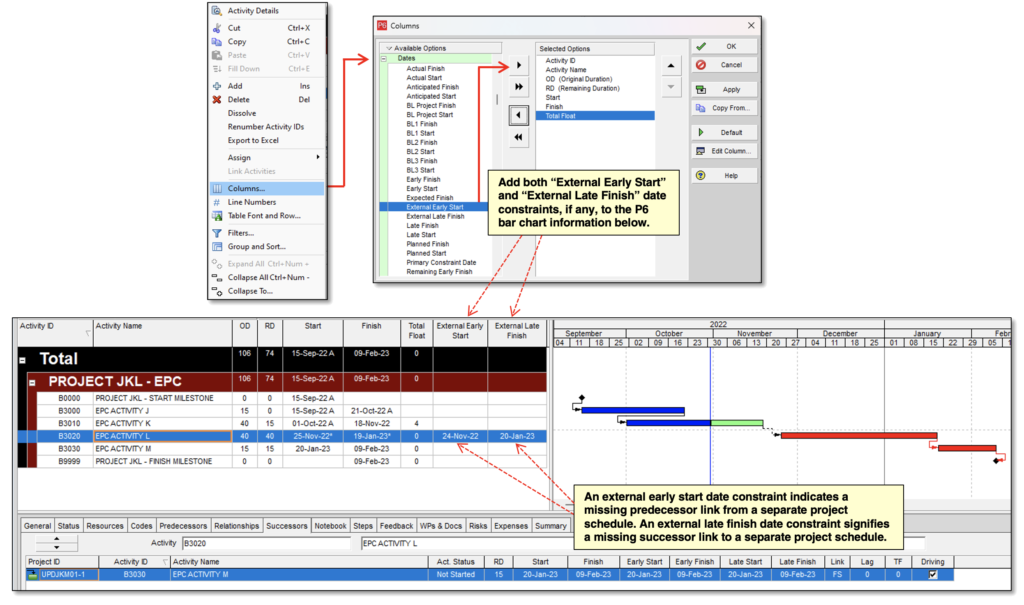
June 19, 2023
Considerations When Encountering External Early Start Date and External Late Finish Date Constraints
This is the fourth blog post in a four-part series about external early start date and external late finish date constraints. This post discusses recommended steps for addressing these constraints in an *.XER data file.
The underlying reasons why external early start date and external late finish date constraints exist in an *.XER data file are often unclear. Good scheduling practice requires identifying the reasons for these constraints, and several steps are recommended. First, after importing a Primavera P6 *.XER backup schedule file into a separate database, check the schedule data for any external early start date and external late finish date constraints by adding external early start date and external late finish date constraint data columns to a Primavera P6 bar chart, as shown in Figure 1 below.
Figure 1: Adding External Early Start and External Late Finish Date Information to a Primavera P6 Bar Chart

Second, if a work activity has an assigned external early start date constraint, external finish date constraint, or both, then the activity has a potentially unidentified or missing predecessor or successor link to a separate project schedule. To determine the reasons for these external date constraints, consider interviewing key project personnel who may have direct knowledge concerning the external date constraints. If knowledgeable project personnel are unavailable, research contemporaneous project records, such as letters, emails, monthly reports, weekly meeting minutes, daily logs, change order files, requests for information (RFI), MEP permits, material delivery reports, etc. for scope interfaces between relevant project participants.
Third, once the reasons for the constraints are understood, consider what causal effect the constraints may have on the schedule file being analyzed. For example, when analyzing schedule impacts over various periods of time, it is possible that the missing predecessor link, via external early start date constraint, may continue to cause schedule delay to the schedule file being analyzed. Consequently, the true reasons for delay may be overlooked. Further, ongoing schedule delays may cause unknown schedule impacts to independent successor schedules if external late finish date constraints are present. To properly identify all sources of delay, it is important to know the potential impacts from other independent project schedules when external early start date and external late finish date constraints exist.
ADDITIONAL RESOURCES

Blog
Discover industry insights on construction disputes and claims, project management, risk analysis, and more.
MORE

Articles
Articles by our engineering and construction claims experts cover topics ranging from acceleration to why claims occur.
MORE

Publications
We are committed to sharing industry knowledge through publication of our books and presentations.
MORE
RECOMMENDED READS
External Early Start Date and External Late Finish Date Constraints
This is the first blog post in a four-part series about external early start date and external late finish date constraints.
READ
External Early Start Date Constraints
This is the second blog post in a four-part series about external early start date and external late finish date constraints.
READ
External Late Finish Date Constraints
This is the third blog post in a four-part series about external early start date and external late finish date constraints.
READ

